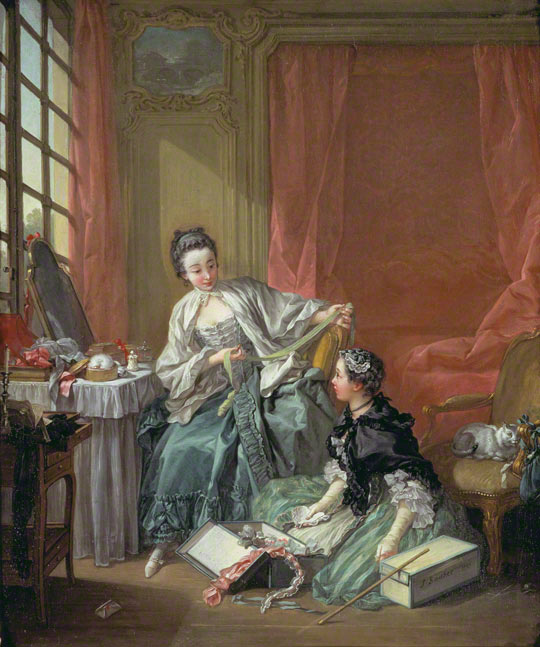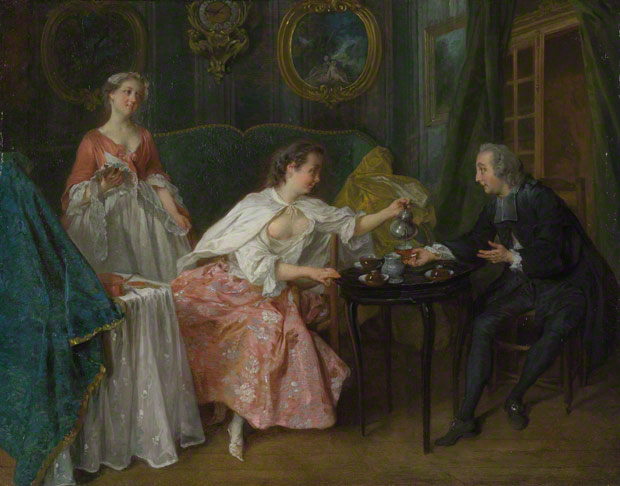
Lady Fastening Her Garter (also known as La Toilette), François Boucher, 1742. Oil on canvas. Image courtesy of and © Museo Thyssen-Bornemisza, Madrid
When posh Parisians in the mid-18th century greeted the day, their morning ritual wasn’t anything like our hasty shower, breakfast, and dash out the door. Their toilette, or ritual of rising and dressing, was an hours-long activity of luxurious pampering, primping, wardrobe assessment, and even worldly affairs.
Yes, it was customary for elite Parisians to have important meetings while still in their dressing robes and undergarments.
Originally a ritual of court society introduced by King Louis XIV, the toilette—not to be confused with the modern word for “bathroom”—is one of the most entertaining topics in 17th century France. Once adopted as an activity among the wealthy, the toilette (deriving from the French word for a cloth—or toile—that covered the dressing table) became a display of conspicuous consumption that declared one’s rank in society.
The more public portion of the ritual was performed with the assistance of servants after a private session of washing and grooming. The washing was done with cloths or sponges—for baths, you see, were not yet in vogue generally. People still subscribed to an ancient theory of the “four humors” that equated health with a balance of substances in the body. Immersion in hot water on a regular basis might disturb those humors, although that superstition was beginning to evaporate towards the end of 18th century.
Once freshened up, a prosperous Parisian monsieur or madame would be dressed by a valet or maid. The lady might have had a silver service de toilette (like the one below) that would put a modern movie star’s vanity table to shame—complete with silver mirror; candlesticks; boxes for jewelry, pins and combs; powder and cosmetic pots; and a box for toothpaste made from roots and herbs. What kind of makeup was kept in such shiny vessels? A concoction of apples mixed with animal fat was a popular moisturizer.

Toilette Service (Service de toilette), Several artists directed by Étienne Pollet, 1738–39. Silver; boar’s hair bristles; modern velvet; and modern glass. The Detroit Institute of Arts, Detroit, Michigan. Founders Society Purchase, Elizabeth Parke Firestone Collection of Early French Silver Fund, 53.177–.192
A coiffure was equally critical to the female beauty regimen, and a hairdresser or maid would take time weaving in ribbons or lace. (Lace was a status symbol worn by men, too, on their cuffs and collars as cravats. King Louis XIV even had lace as a budget expense!)
Where would the elite acquire such finery? Enter The Milliner, a door-to-door saleslady modeling the latest fashions.

The Milliner, François Boucher, 1746. Oil on canvas. Nationalmuseum, Stockholm. Photo © Erik Cornelius – Hans Thorwid
This painting by François Boucher represents a young woman as a fashionista with a measuring stick, proffering boxes of ribbons and other hair ornaments to her upper-class customer at her toilette. The accessory table pictured at left in the painting is much like the one in this fun video of a mechanical table. You can see it also doubled as a handy book rest or writing table.
Besides a husband or children wandering into a lady’s toilette—such as in Portrait of Madame Marsollier and her Daughter—other visitors might also make a morning call. The Four Times of Day: Morning, a painting of a woman at home shows her having tea with her confessor, who is distracted by her state of undress.

The Four Times of Day: Morning, Nicolas Lancret, 1739. Oil on copper. The National Gallery, London. Bequeathed by Sir Bernard Eckstein, 1948. © The National Gallery, London
“He can barely hold his cup,” said Charissa Bremer-David, curator of sculpture and decorative arts at the Getty Museum and the exhibition’s co-curator, pointed out to me. “Ostensibly, this is an encounter between a woman and her religious advisor, but are they talking about soul-saving subject matter? Hard to know.”
Even more flirtatious is Lady Fastening Her Garter or La Toilette (pictured at the top of this post), which shows a woman in a disheveled room surrounded by a jumble of accessories on the mantle and a cat playing with yarn at her feet. The disarray and her splayed legs suggest she was a coquette, a woman of loose morals.
Though pleasing to the eye, such paintings depicting fashionable interiors, luxurious accessories, and elite pursuits could subtly convey moralizing reminders about fleeting beauty, the perils of vanity, and the lure of worldly possessions.
Vanity aside, the long morning ritual of the toilette was basically about dressing for success. It was an excellent way to invite special visitors for morning croissants and tea, show off your luxurious home, strike deals, and cement political alliances. It was a power breakfast inspired by a king.
_____
This blog post was originally published in conjunction with the 2011 Getty exhibition Paris: Life & Luxury,




The Sofia Coppola version of “Marie Antoinette” has a pretty good depiction of the state version of the toillette.
Damn! Why don’t you guys send these emails out sooner (like a month or two) so those who live out of town can plan on seeing this?
If I would have known sooner, I could have made arrangements to come down to see this.
🙁
Hi Matt — Oh no, sorry you just heard about “Paris: Life & Luxury”! Good news: it travels to the Museum of Fine Arts, Houston, where it will be presented under a slightly different name, Life & Luxury: The Art of Living in Eighteenth-Century Paris, from September 18 to December 11, 2011. Road trip to Texas?